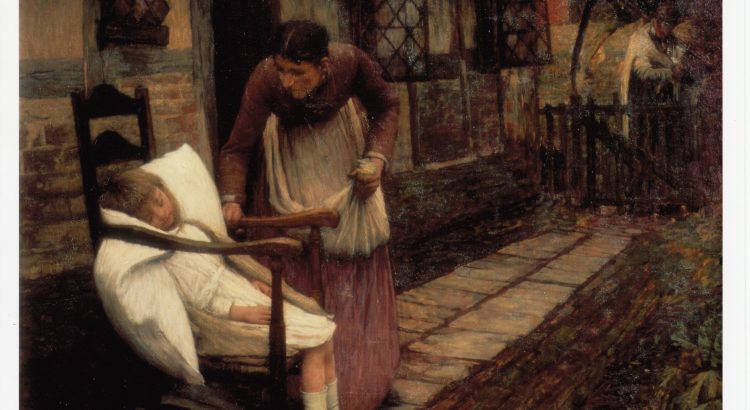Beatrice Emma Mary Balchin, known as Trixie, was the great aunt of The Rt Hon the Lord Lingfield, as a child, always looked forward to his visits to her house Haroldsleigh at Gatton Point in Surrey. Over her bed was a small reproduction of a painting which, she said, hung in the Tate Gallery.
As a young girl, then Beatrice Apps, she had lived in Bosham, a small seaside village on the Sussex coast famous for its ancient church which is depicted on the Bayeaux Tapestry and from which King Harold II set out on his ill-fated voyage to France which was to lead eventually to his death at Hastings and the Norman Conquest of England.
In the eighteen eighties, Bosham was, as now, a picturesque location to which artists came regularly in Summer to paint. Amongst these was the young Henry Herbert La Thangue who in 1879 had won the Royal Academy Schools Gold Medal after attending the South Kensington Schools of Art. He had studied in Paris under Gerome at the Ecole Nationale des Beaux Arts.
La Thangue, as his career progressed, became a well known member of a group of open-air naturalist painters which included George Clausen and Bastien Lepage. They specialised in large works which would show sowers, harvesters and haymakers and other engaged in rural labour. His paintings became regular favourites at The Royal Academy’s exhibitions.
In 1890 La Thangue, decided to make his home in Bosham and became well known amongst the local residents. In 1895 he began a huge canvas, 5’ 6” (165cm) square which was to be known as The Man with the Scythe. For it he chose as models a local farmer and his wife, Mr and Mrs Tukes of Tuke’s Farm and Beatrice Emma Mary who was then seven years old. A thatched cottage, Tuke’s Cottage, was to be the background.
This painting depicts a child, who is clearly an invalid, apparently asleep and propped up by a pillow on a ladder back chair outside the cottage. Her mother, who has collected some vegetables from the garden in her apron, suddenly looks at her with distress; but, alas, death, portrayed by the man with the scythe, is passing by the gate.
It is not as sentimentally painted as some Victorian works, in spite of the symbolism of the scythe. However, the dying girl and her pillow are depicted in warm sunlight, suggesting that she is already in a brighter place, whilst the rest of the cottage and garden are in sombre colours.
Beatrice received a gold sovereign for having to maintain a still pose for so many hours. The Man with the Scythe secured great fame for La Thangue and was bought for the Tate by the Chantrey Bequest. He became an ARA shortly afterwards and a Royal Academician in 1913, dying in 1939. Beatrice Emma Mary Balchin lived on until 1974 and, during her lifetime, paid many visits to the Tate Gallery to see herself as a small girl captured in paint by one of Britain’s most well known post impressionist artists.

